Vermeer Interrupted: A Study of Johannes Vermeer’s “Girl Interrupted at Her Music” at The Frick Collection
Ruth Osborne
In October, ArtWatch opened a discussion on the state of Vermeer paintings in New York collections, with the aim of establishing a greater understanding of each work in its multiple layers of conservation. Unsettling examination of a Vermeer in the Royal Collection at St. James’ Palace by ArtWatch UK has energized our study of Vermeers on this side of the Atlantic.
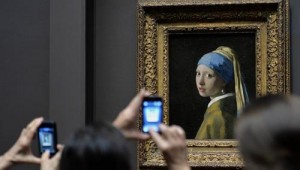
Visitors snapping shots of Mauritshuis’ Girl with a Pearl Earring at The Frick’s 2013 exhibition. Photo: AFP/Getty Images.
While Michael Daley calls London’s National Gallery to task on the blind eye they took to conservation in their recent “Vermeer and Music” exhibition, it appears quite the opposite is being done currently by the Frick. The Frick’s current show, “Masterpieces of Dutch Painting,” begins with conservation propaganda from the Mauritshuis that serves to build up a wall of defense around the changes made as a result of treatment efforts. The first large room (of only two for this exhibition) focuses the viewer on two simple items: Vermeer’s famed Girl with a Pearl Earring and a panel on the scientific “discoveries” of its conservation treatment in 1994.[1]
The Mauritshuis’ publication Vermeer Illuminated states that, as of the spring of 1994:
“The Girl with a Pearl Earring was in a relatively good state of conservation. There were no imminent threats to the material condition of the painting…However, from an aesthetic point of view, the painting was not in good condition. The varnish had yellowed considerable and the old retouches had discoloured to such an extent that they looked like dark shadows.”
So essentially, conservators at the Mauritshuis put their hands once more to Vermeer’s canvas to undo previous bad restoration work. This is not something out of the ordinary for conservators, but the degree to which it lends to the debilitating of an artist’s oeuvre over several decades is astonishing. In Vermeer Illuminated, Mauritshuis makes sure to mention that their in-house conservators and restorers only set about the 1994 treatment “after consulting the international support committee,” which would no doubt give them the green light on removing the old varnish and touch-ups only to “sparingly retouch with stable materials” and revarnish.[2]
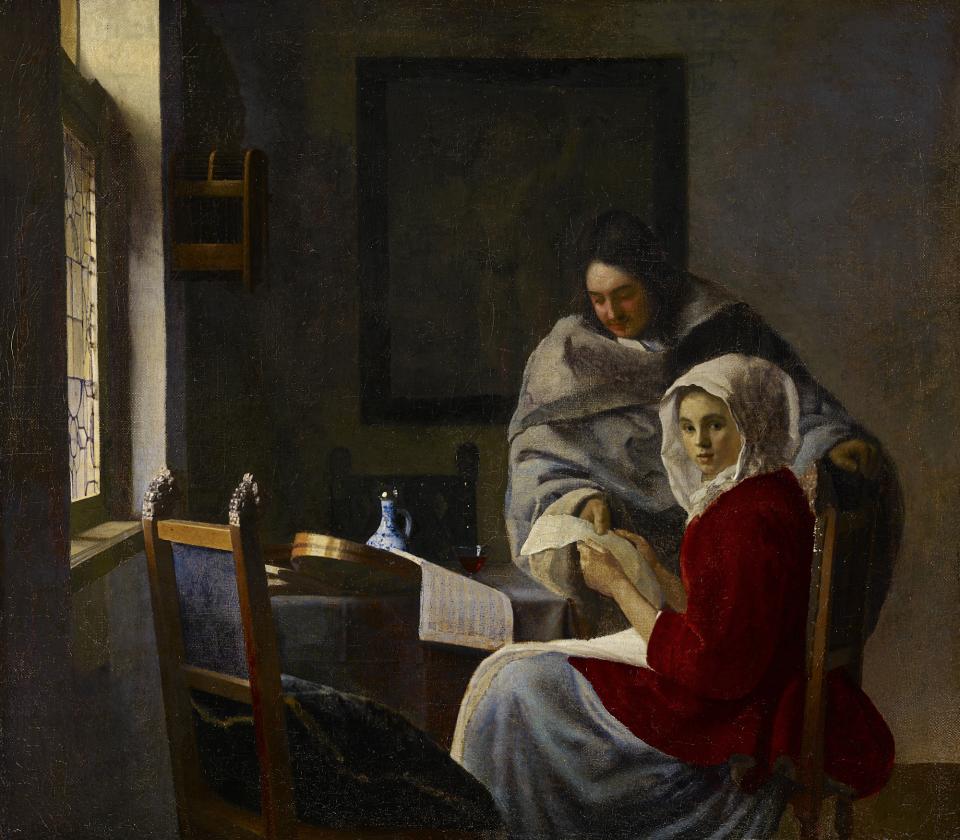
Johannes Vermeer (1632–1675) Girl Interrupted at Her Music, 1658–59 (detail). Oil on canvas. The Frick Collection, New York. Photo: Michael Bodycomb.
This post will focus on the first Vermeer to enter Henry Clay Frick’s hands, Girl Interrupted at Her Music (c. 1660). There is a general lack of knowledge about his oeuvre until being put on the map by Gustave Friedrich Waagen and Théophile Thoré-Brüger’s monograph survey essay in the early nineteenth-century. This gap of scholarship creates considerable problems for understanding the various damages and retouchings that occurred in subsequent decades.
Even before Girl Interrupted at Her Music entered Frick’s collection in 1901, Vermeer scholar Hofstade de Groot reported in 1899 on issues of inconsistency within the canvas. He noted the existence of a bird cage and violin painted-in by a later hand, which had by that point been painted over with the picture of Cupid that still appears today. The website “Essential Vermeer,” devoted to a close examination of the artist’s works, acknowledges both de Groot’s grievance and other issues due to “heavy-handed restorations.”[3] De Groot also took offense at the bird cage and violin hanging on a wall in the background which appeared to be a recent addition. In 1908, seven years after the painting entered Frick’s collection, de Groot relates conservation treatment with these issues of pictorial inconsistency: “This picture of Cupid became visible when the work was cleaned. Its place was formerly occupied by a violin and bow, noticed in the catalogue of the Smeth van Alphen sale of 1810.”[4] In 1995, Martin Bailey maintains that Girl Interrupted at Her Music is “in worn condition and the birdcage hanging on the wall near the window may be a later addition by another artist”[5]; the present day conservator of the Frick Collection backs this judgment.[6]
Girl Interrupted was also not so highly-admired among Frick’s purchases of this time. Today, the Frick places heavy blame on restorers who ruined the canvas with treatment between the time of Frick’s purchase and the painting being brought into the collection. Secondly, they place blame on the Knoedler dealer Charles Carstairs, who worked with Frick in his purchasing from the gallery:
“By all accounts, Frick’s 1901 acquisition of Vermeer’s Girl Interrupted at Her Music seems to have been a wise although not a calculated decision…Whatever his motivation, Frick paid Knoedler $26,000 for the Vermeer, a high price when compared to the amounts his contemporaries had spent for their Vermeers about this time. As was the common practice, the Girl Interrupted at Her Music, which had been in a private collection in Britain for almost a half century, was thoroughly cleaned shortly before it was sold. As a result, a violin hanging on the back wall, described in the 1810 auction catalogue, was removed by the restorer, who judged it a later addition. The birdcage to the right of the window, which may not be original to the painting either, was left intact. Although Frick probably was not aware of the fact, the Girl Interrupted at Her Music was only the fourth authentic Vermeer to come to America.”[7]
Only three years after the acquisition, Frick allowed Girl Interrupted at Her Music to be placed on loan for the Louisiana Purchase Exposition in 1904.5 Considering the ill-repute the canvas already held on its entering the collection, it is difficult to say the traveling and handling involved with the St. Louis Expo would not have heaped even more damages. It was again lent in 1909 to the Metropolitan Museum of Art’s Hudson-Fulton Celebration, another grand, city-wide affair honoring an anniversary in U.S. history.[8] Unfortunately, the catalogue from the 1909 exhibition only reproduces the picture with overly-enhanced areas of contrast so that the level of detail in the picture disappears.
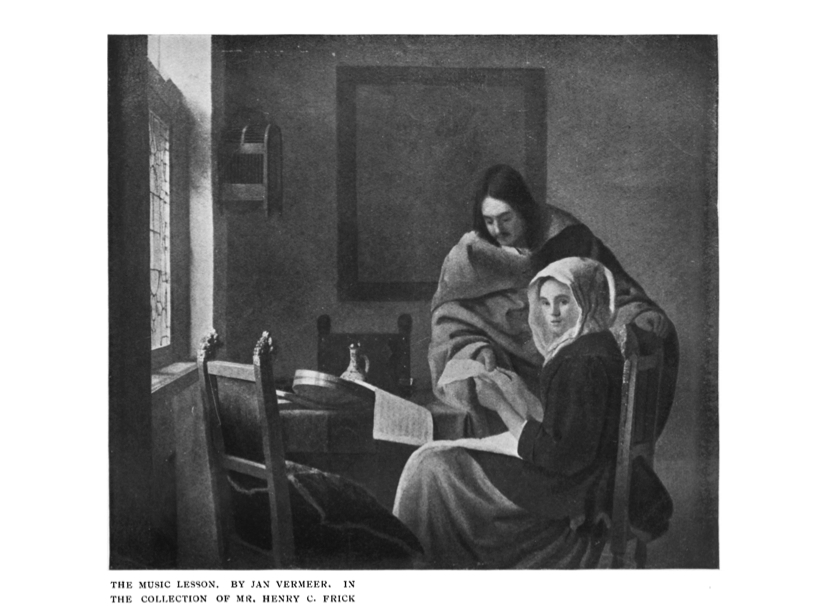
Girl Interrupted at Her Music from Kenyon Cox’s 1910 publication. Photo: The Burlington Magazine for Connoisseurs (Jan. 1910).
As is evident from Kenyon Cox’s reproduced image of the painting in The Burlington Magazine of that same year, Girl Interrupted shows a few thick areas of shadow around the lower portion of the man’s upper lip and neck, which no longer appear today. Cox remarks in his short essay, that Girl Interrupted (listed as Music Lesson) is “difficult to classify.” He goes on to remark that, while the painting shows “exquisite passages” and “characteristic lighting,” it still “does not seem quite to hang together. The composition and the values are confused. There has evidently been some retouching needed, and the work of the restorer may account for the puzzling effect.”[9] Other critics after Cox also remark upon the awkward treatment of light and shadow. For example, Philip Hale suggests in 1913 that the “ridiculous folds” of the girl’s dress “may have been repainted by some clumsier hand than Vermeer’s.” Furthermore, as with Cox, Hale also takes issue with the execution of light that fails to fall across the figures in the way Vermeer typically demonstrates.[10]
So what, then, would be the point in bringing “restoration” to a painting that has already been handled by supposed “restorers” and has come out damaged on the other side? Just how did those in charge of Frick’s collection see any possibility of bringing out the “true” Vermeer Girl Interrupted? It is the myth of the profession of paintings conservators that a hand skilled in minutiae and a mind steeped in chemistry can heal blemishes that occurred in the name of conservation in the first place. The loan of Girl Interrupted in its early years in Frick’s collection resulted in the damage one might assume from travel wear. As a result, some minor work was performed on the canvas stretcher and surface. However, by the late 1930s enough concern arose to recommend a complete overhaul of the painting’s appearance in order to attempt a recovery from centuries of abrasion and poor past restoration efforts.
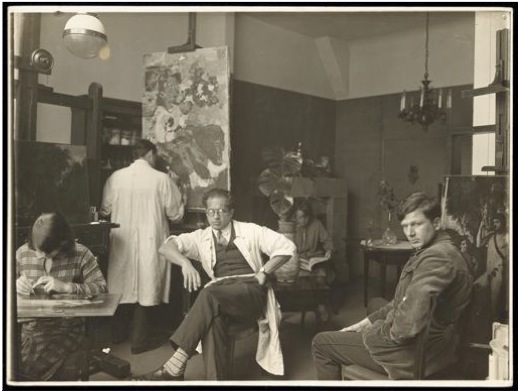
Suhr (center) in his Berlin Studio, ca. 1920. Photo: Allison Stewart.
The conservator who would complete a full conservation treatment on Girl Interrupted was the Metropolitan Museum of Art’s very own William Suhr. Suhr has been examined by ArtWatch UK as the fateful “restorer” of Turner’s Rockets and Blue Lights at the Clark Institute. This treatment met an unfortunate end in the disappearance of a second steamboat; meanwhile, the trustees presented the final product as an “effectively new picture.” Indeed it was. The Clark Turner was a case of re-restoration, just as the Frick’s Girl Interrupted. In both cases, we are left with muddled or flattened canvases that confuse the eye and disrupt the original artist’s hand.
Suhr’s background at the Kaiser Friedrich Museum in Berlin, later work under William R. Valentiner (then-Director of the Detroit Institute of Art) in the 1920s, and performance for private collectors on both coasts of the U.S. eventually led him to a great appointment to restore Frick’s Polish Rider by Rembrandt. His approach to treating Frick’s Girl Interrupted in 1949 was quite typical, but not revelatory in results: he removed the poor inpainting from former restorers, and in so doing was forced to remove old varnish, uncovered an even more abraded and stripped canvas (an image of which ArtWatch is prevented from publication at the request of The Frick Collection), and then proceeded to retouch Vermeer’s original brushstrokes and cover with a final revarnish.
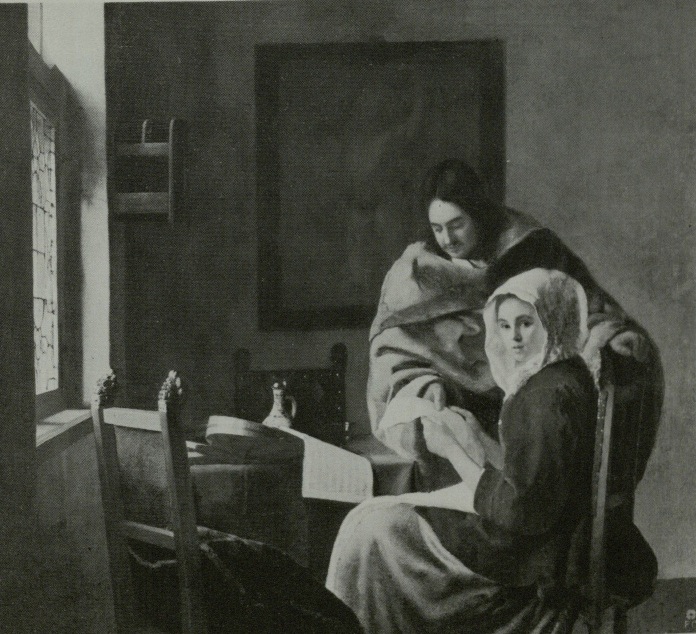
Girl Interrupted, as appears in Blankert’s 1975 publication. Photo: Albert Blankert, 1975.
A post-cleaning image of Girl Interrupted is reproduced in Albert Blankert’s Johannes Vermeer van Delft, 1632-1675 (1975). Here, one sees that Suhr had attempted to fix the “ridiculous folds” of the girl’s hood. He has repainted the hood so that it now appears with less-defined folds on the side. Also altered is the area where her red jacket meets her blue skirt and the sheet music she is holding. Now, it appears her jacket comes to a point at where it hadn’t before.[11]
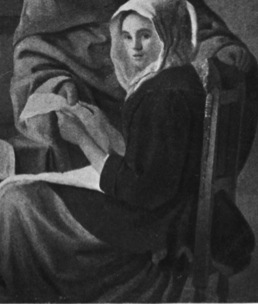
Girl Interrupted, 1910 (detail, pre-restoration)

Girl Interrupted, 1975 (detail, post-restoration)
Suhr’s treatment, the most extensive conservation work recorded on the painting while at the Frick, quickly fell into disfavor with examinations in the following decades. What followed is exactly what is to be expected: yet more minor retouching and revarnishing performed. Restorations done over in the span of only three decades do not bode well for the health of the canvas. ArtWatch UK has produced bountiful evidence on the damage of re-restoration on a Vermeer at the National Gallery in London. ArtWatch UK Director Michael Daley is right in asserting that conservators’ hands have as much to do with the current handed-down appearance of a painting as do the abrasions and wear that Museum displays and exhibitions tend to emphasize. In the case of Girl Interrupted, one sees this in the Frick’s website’s mention of inconsistencies due to bad restorations pre-Frick’s ownership.
It is astounding to think that, while Suhr was certainly considered one of the top conservators in his day, his treatments just a few decades later received major criticism, and rightly so. Suhr’s work attempted to recover what others before him had failed to fix. Come 1981, Arthur Wheelock addresses lingering issues in Girl Interrupted: “Unfortunately, this painting is in very bad condition. Only the still-life area preserves something of its original surface qualities.”2 Just as Suhr’s work on the Clark’s Turner was gone over again by David Bull a few decades later, so too did his pass at Girl Interrupted prove to be unsatisfactory for restorers in the 1980s. Does this not provide a clear warning as to the abilities (or lack thereof) of the conservation profession in restoring truly damaged paintings?
While over-restoration has clearly proven of no assistance to this picture, is it possible the canvas has been so dismantled over the years that it now lacks significant trace of Vermeer’s original hand? Photographic record only goes back to the late nineteenth-century and the author has been unable to turn up any illustration from the 1810 auction catalogue (its first illustrated appearance, which is cited by de Groot in the 1908). Additionally, various elements in the painting tell of the portmanteau compositions churned out by forgers in great numbers at the turn-of-the-century, just when this painting first arrived in publication and exhibition. For instance, several pieces of this canvas relate quite closely to Vermeer’s Glass of Wine (National Gallery, Washington): the angle of the chair by the window with lion’s-head finials, the painting of Cupid in the same spot on the back wall, the composition and placement of the two main figures, and finally, the angled position of the stringed instrument on the table. Admittedly, the chairs, window, and musical instrument are also all elements that Vermeer carries throughout other canvases (The Girl with the Wine Glass at the Herzog Anton Ulrich Museum, Baraunschweig, Young Woman Standing at a Virginal, National Gallery, London, and The Music Lesson, Royal Collection, London, among others). The Frick has also permitted Girl Interrupted and their other two Vermeers for several forms of scientific analysis that would prove it originates in the proper time and place for it to be considered a Vermeer. Still, the small, now much weakened, canvas is unable to stand on its own without a series of explanations as to its excessive damage and overworked surface.
What strikes the eye when viewing Girl Interrupted is indeed the sheer flatness of the picture, lacking the detail of more delicate light and shadow. In cleaning, Suhr’s attempt to adjust previous conservators’ over-painting and marks of abrasion only resulted in a picture stripped of its dimensional qualities. Whatever mistakes were made by nineteenth-century restorers, Suhr’s treatment, along with other pressures on the canvas from travel, only made what was already bad a little bit worse. It is understandable that one would want to do whatever was possible to improve upon a $26,000 investment. However, the evidence presented 100 years after Frick’s purchase shows touching and retouching a painting does not always do the trick.
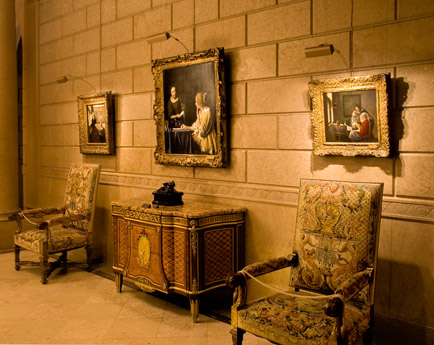
The Frick Collection’s 3 Vermeers as they appeared in a 2008 display in the South Hall. Photo: Art and Living.
Today, Girl Interrupted at Her Music appears above a French tapestry-covered chair in the Frick’s South Hall, balanced at the other end of the room with a quite different-looking Vermeer canvas entitled Officer and Laughing Girl (c. 1657). While these two paintings are spaced a good deal apart, the eye cannot lie. The varying shades of light and color, as well as the surface texture (or lack thereof) relates to the viewer the canvases divergent restoration histories. As we have stated in a previous post, Vermeer paintings in New York collections appear as if they were composed by completely different artists. Similar issues exist in works by Vermeer at the Metropolitan Museum of Art, which will be discussed in a later post.
[1] Jørgen Wadum, René Hoppenbrouwers, and Luuk Struick van der Loeff, Vermeer Illuminated: A Report on the View of Delft and The Girl with a Pearl Earring by Johannes Vermeer. (The Hague: V+K Publishing/Inmerc, 1994) 18-23.
[2] Vermeer Illuminated, 22.
[3] “Girl Interrupted at Her Music by Johannes Vermeer,” Essential Vermeer. http://www.essentialvermeer.com/catalogue/girl_interrupted_in_her_music.html (last accessed 22 November 2013).
[4] C. P. Hofstede de Groot, with W.R. Valentiner. Translated and edited by Edward G. Hawke, Catalogue Raisonné of the Works of the Most eminent Dutch painters of the Seventeenth Century. Vol. 1 (London: MacMillan and Co., Limited, 1908). Listed in de Groot as “A Gentleman and a Young Lady.”
[5] Martin Bailey, Vermeer. (Phiadon Incorporated Limited: London, 1995).
[6] “Girl Interrupted in her Music by Johannes Vermeer,” Essential Vermeer. http://www.essentialvermeer.com/catalogue/girl_interrupted_in_her_music.html (last visited 20 September 2013)
[7] Esmée Quodbach, Assistant to the Director of the Center for the History of Collecting in America, “Frick’s Vermeers Reunited,” 2008. The Frick Collection: Exhibitions. http://www.frick.org/sites/default/files/archivedsite/exhibitions/vermeer/frick.htm (last accessed 17 November 2013).
[8] Wilhelm R Valentiner, Curator of Decoartive Arts, Catalogue of Painting by Old Dutch Masters, Hudson-Fulton Exhibition, Catalogue of a loan exhibition of paintings by old Dutch Masters held at the Metropolitan Museum of Art in connection with the Hudson-Celebration, September-November 1909 (Metropolitan Museum of Art: New York, 1910) p. 139 (no. 138)
[9] Kenyon Cox, “Dutch Pictures in the Hudson-Fulton Exhibition-II,” The Burlington Magazine for Connoisseurs, Vol. 16, No. 82 (Jan. 1910) 246.
[10] Philip Hale, Jan Vermeer of Delft. (Boston, 1913), 254-55.
[11] Albert Blankert, Johannes Vermeer van Delft, 1632-1675. (Utrecth: Spectrum, 1975) 201.

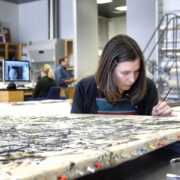

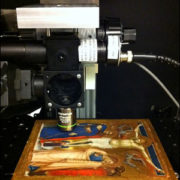


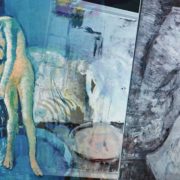


Leave a Reply
Want to join the discussion?Feel free to contribute!